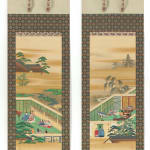Watanabe Hiroteru (1778-1838)
Each signed 'Minamoto Hiroteru kinga' [respectfully painted by Minamoto Hiroteru] and sealed 'Hiroteru no in'
In fitted wood storage box (tomobako)
126.3 x 50.3 cm. (49 ¾ x 19 ¾ in.) (each, unrolled, painting only)
78 (l) x 21.5 (w) x 11.5 (h) cm. (30 ¾ x 8 ½ x 4 ½ in.) (fitted wood storage box)
Further images
Watanabe Hiroteru (1778-1838) studied painting as a boy at Zempukuji Temple in Tokushima Domain, where his uncle was the chief priest of the temple. In 1796 he left for Edo and entered the school of Hiroyuki Sumiyoshi (1755-1811), who was the 5th head of the Sumiyoshi school of painting. In 1809 he was formally employed as a painter of the school and lived mainly in Edo. In 1812 he stayed in Tokushima for about a year, during which time he painted fusuma (sliding doors) at Zempukuji Temple. A relatively large number of his works remain in Tokushima Prefecture.
The Sumiyoshiha (Sumiyoshi school) specialised in the yamato-e style, a general term applied to paintings whose subject matter or style are considered Japanese, as opposed to having been influenced by Chinese art, such as the work of the Kano school. The Sumiyoshi school was founded in 1662 by Jokei (1599-1670), a former member of the court-sponsored Tosa school, who established his own atelier in Edo. Whereas the Tosa school worked for the court in Kyoto, the Sumiyoshi school worked primarily for the shogunate in Edo. The style of both schools is characterised by flat, decorative compositions, fine line work, a miniaturistic attention to detail and brilliant colour, as in the present pair of paintings. The aristocratic patrons of such paintings favoured subjects based on classical literature such as Ise monogatari (Tales of Ise) and Genji monogatari (The Tale of Genji) - the eleventh-century classic of literature by the court lady Murasaki Shikibu.
This pair of hanging scrolls illustrates two famous scenes from two chapters of The Tale of Genji – chapter 3 Utsusemi (The Shell of the Cicada) (right scroll) and chapter 9 Aoi (Heartvine) (left scroll).
Right scroll:
Utsusemi is the name of the woman who continuously manages to evade Genji’s persistent advances. In this chapter of the tale, Genji visits the mansion of the Governor of Kii, Kii no Kami and spies on Utsusemi playing a game of go with the Governor’s sister, Nokiba no Ogi, both revealingly underdressed in the warm summer night. Later, aided by Utsusemi’s young brother, Genji searches for Utsusemi in her room, but she flees just in time and Genji, mistaking Nokiba no Ogi for her, makes love to the other woman. The go game scene is the most frequently illustrated from this chapter and is beautifully depicted in fine detail on the right scroll of the present paintings. Genji accompanied by Nokiba no Ogi’s brother can be seen spying on the two women playing go through a bamboo blind at the doorway to the room within the mansion. A candlestick illuminates the interior of the tatami room and beside the women is a lacquer cabinet with books and scrolls, a lacquer incense burner and a six-panel folding screen (Byobu).
Left scroll:
Genji is depicted trimming the hair of the young Murasaki, whom he adopted at the end of chapter 5 and with whom he is much taken. She stands on a go board and has her hair cut in preparation for attending the festival at the Kamo Shrine. The title of the chapter, Aoi, refers to Genji’s wife who is one of the three women depicted in the room with Genji and Murasaki, and who at this time is struggling with a difficult pregnancy with Genji’s son (Yugiri). She dies shortly after giving birth, a victim of the jealous spirit of Genji’s former lover, the Rokujo lady.
Works by Watanabe Hiroteru in museum collections:
· The Museum of Fine Arts, Boston, pair of Genji scrolls, accession nos. 11.4556 and 11.4555, go to:
· Tokushima City Museum, pair of Genji scrolls, go to:
https://www.city.tokushima.tokushima.jp/smph/johaku/meihin/page01-00/page05-04.html
· Tokushima Prefectural Museum, pair of scrolls, designated as a Prefectural Cultural Property of Tokushima
· Nakanoshima Kosetsu Museum of Art, pair of Genji scrolls
· Shizuoka Prefectural Museum, go to:
https://spmoa.shizuoka.shizuoka.jp/collection_vote/artist.php?AD=wa---watanabe_hiroteru










